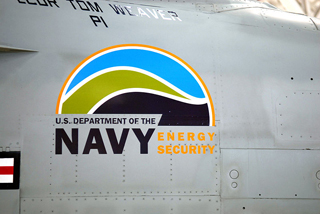The Military Plays an Important Role in Biofuel Procurement
 The military’s FY2013 budget is playing out to be a hot-bed of debate over the role of government in supporting clean energy innovation. Both the U.S. House of Representatives and the Senate Armed Services Committee passed Department of Defense (DOD) budgets that bans the department from developing or purchasing advanced alternative energy fuels that cost more than traditional fossil fuels. While most of the resulting media focus has been on weighing the possible advantages associated with biofuel use relative to its cost, too little attention has been paid to the important role the DOD can play as a technology-first adopter.
The military’s FY2013 budget is playing out to be a hot-bed of debate over the role of government in supporting clean energy innovation. Both the U.S. House of Representatives and the Senate Armed Services Committee passed Department of Defense (DOD) budgets that bans the department from developing or purchasing advanced alternative energy fuels that cost more than traditional fossil fuels. While most of the resulting media focus has been on weighing the possible advantages associated with biofuel use relative to its cost, too little attention has been paid to the important role the DOD can play as a technology-first adopter.The ban came about in large part due to controversy over the U.S. Navy’s investments in advanced biofuel RD&D, which ITIF has previously covered. The Navy’s efforts are primarily centered on making the service less vulnerable to oil price fluctuations and potential disruptions in oil supplies, which also falls under the DOD’s broader goal of developing more energy efficient, non-fossil-fuel fuels and technologies in order to increase war capabilities. As Navy Secretary Ray Mabus claimed last year, the Navy is pursuing alternative energy sources “primarily for one reason: it makes us better warfighters.” Nevertheless, as biofuels have been procured by the Navy at prices significantly higher than regular fuel, cost has been the primary concern of policy critics.
“In a tough budget climate for the Defense Department, we need every dollar to protect our troops on the battlefield with energy technologies that reduce fuel demand and save lives,” Senator John McCain commented on the Senate Armed Service Committee vote. “Spending $26 per gallon of biofuel is not consistent with that goal.”
In fact, as detailed in a previous ITIF blog post, while the algae and cooking oil purchased by the Navy last year did cost roughly $26 a gallon, the resulting biofuel blend for actual military use only cost about $15 a gallon. Even the $26 figure, however, represents a substantial drop in price over the course of one year, as the Navy had bought 20,055 gallons of algae biofuel in October 2010 for $424 per gallon. That drop, again, has been attributed to “continued research and a growing commercial market for biofuel”, which highlights the DOD’s unique ability to foster emerging energy technologies through procurement. As Bloomberg Businessweek pointed out, “the department is the nation’s largest consumer of energy, spending about $15 billion last year on fuel for tanks, ships, aircraft and other operations. In Afghanistan, the military uses more than 50 million gallons of fuel each month.” This fact not only informs the military’s need to develop alternative energy sources out of strategic considerations, but also underlines its purchasing power. As ITIF’s Lean, Mean, and Clean report on DOD energy innovation observed, “large-scale purchasing of new technologies creates early markets for new technologies, allowing private firms time to grow and gain productive experience, while also driving cost reductions and technology performance improvements.”
While biofuels are undeniably costly relative to conventional fuels, by providing an early market, the military can help ensure that this will not always be the case. Fred Kaplan points out at Slate that the microchip “was first demonstrated at the radio industry’s tech show in 1959, to little fanfare because, at $35 per chip, it was too expensive for any commercial application.” Nevertheless, the government’s decision to build the Minuteman II missile in the 1960s created a market for the product, whereupon “the extra production spawned economies of scale, which brought the costs down to the point where commercial products were feasible, which triggered further demand, which spawned greater economies of scale and competition from other firms, which lowered prices further…and on it went, until 1971, when the price for a chip had plunged to $1.25. (By 2000, it was down to 5 cents.)” Today, the biofuels industry is at a “tipping point” for commercialization, as was the consensus of an expert panel at a recent International Finance Corporation workshop. One biofuel entrepreneur, Tom Todaro, credits DOD policy for the industry’s progress in recent years: “We’d be years behind if it wasn’t for the military.”
Of course, it’s clear that policymakers have an alternative agenda: the proposed ban on advanced biofuels includes an exception that allows the DOD to pursue more expensive fuels derived from coal and natural gas. And that’s unfortunate because in a short time, DOD’s robust innovation ecosystem has accelerated progress of a clean, next-generation technology that could have not only significant military benefits, but commercial ones as well. These are exactly the type of lower-cost (the $12 million Navy biofuels procurement represents less than 0.00002% of the $643 billion allocated by the House for DOD spending inFY2013), high-impact innovation investments government has made with great effect in the past and should continue to make.
You can return to the main Market News page, or press the Back button on your browser.

